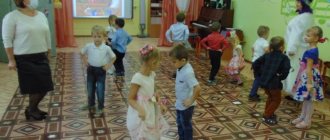Junior group
For younger preschoolers, simple educational, active and musical games are recommended.
Post a flower
Make two paper daisies for the game with the petals separated from the core. The number of petals must correspond to the number of players. Place daisies on the floor near the wall. Divide the students into 2 groups with an equal number of players.
Invite teams to move their daisy to the opposite wall. Each player transfers only one part of the plant: the first - the yellow core, the second - the petal, and so on. A player is not allowed to take two petals at once. The next participant starts moving when the previous one returns to the start. The team that collects its daisy first wins.
Collect a bouquet
Before playing, tell the children what parts flowers are made of: core, petals, stems and leaves. Cut out plant parts from colored paper and glue them into a bouquet arrangement, but do not glue the petals. Make petals of a certain color from the main spectrum for each flower. Tell the students that the wind tore off the petals, which now need to be selected according to the color for each plant in the bouquet.
You can also offer students a similar didactic game “Collect a flower.”
Bells
Children choose a leader by lot. He leaves the room. The players hide a picture depicting a blooming bell in the game room, disassemble the musical instruments themselves - small bells, and distribute them throughout the room. Moreover, one of the players must stand close to the hidden image.
The presenter enters the playroom, begins to walk around it, and approaches the children. When he approaches a player who is standing far from the picture, he does not ring the bell. When he approaches a participant standing closer to the picture, he makes a quiet ringing sound. The leader approaches the target even closer - the player makes a louder sound. The participant closest to the others rings the loudest. This way the presenter understands where to go in searching for the picture.
A flower is blooming
The game is educational. First tell the children how flowers bloom in nature. Prepare plant templates and distribute to students. Show how to curl the petals. Let the children put the flowers in a glass of water and observe what happens to the petals. When exposed to moisture, the petals will begin to “bloom.”



